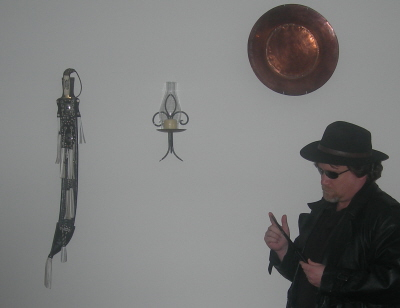|
About This Author
Come closer.
|
Complex Numbers
Complex Numbers
A complex number is expressed in the standard form a + bi, where a and b are real numbers and i is defined by i^2 = -1 (that is, i is the square root of -1). For example, 3 + 2i is a complex number.
The bi term is often referred to as an imaginary number (though this may be misleading, as it is no more "imaginary" than the symbolic abstractions we know as the "real" numbers). Thus, every complex number has a real part, a, and an imaginary part, bi.
Complex numbers are often represented on a graph known as the "complex plane," where the horizontal axis represents the infinity of real numbers, and the vertical axis represents the infinity of imaginary numbers. Thus, each complex number has a unique representation on the complex plane: some closer to real; others, more imaginary. If a = b, the number is equal parts real and imaginary.
Very simple transformations applied to numbers in the complex plane can lead to fractal structures of enormous intricacy and astonishing beauty.
September 9, 2023 at 10:01am September 9, 2023 at 10:01am
| |
Double whammy today: a math article from LitHub, and one that's actually relevant to the blog title.
1. Of course it was human innovation. We don't have AIs innovating yet, and the limit of feline innovation is to see how much stuff you can knock off the counter before the human yells at you.
2. "Convenience?" More like "crutch." I learned math with a slide rule, dammit!
Late in 1957, as Tadao and Toshio Kashio waited to load their desk-sized calculator onto a plane at Tokyo’s Haneda Airport, they were told they would have to dismantle it first. If you can just remove this top part here, an attendant told them, gesturing to the keyboard and display, it will fit on the airplane.
If only they had a means of calculating the space needed.
The Kashio brothers—Tadao, Toshio, Kazuo, and Yukio—were quite different from the inventors and engineers who had gone before them. They did not have Blaise Pascal’s mathematical prowess, or Samuel Morland’s royal connections. They did not have Charles Xavier Thomas’s considerable income, or Curt Herzstark’s family tradition of engineering. What they did have was a finger-mounted cigarette holder that let Japan’s workers get their nicotine fix both on and off the job.
Now that's brilliant.
Back in 1946, [Toshio] had read a newspaper article that chronicled the battle of wits between Kiyoshi Matsuzaki on his abacus and Tom Wood of the U.S. Army on his electric calculator.
Regular John Henry story there.
Toshio decided then that Kashio Manufacturing would build an electric calculator, economy be damned, and that it would do so in a completely new way.
People in Japan did a similar thing with scotch. Oh, yeah, and cars. But the scotch thing is important. Of course, they can't call it scotch.
Figuratively speaking, it was revolutionary; in literal terms, it was the opposite, since this was the first automatic calculator anywhere in the world that was not driven by rotating gears or motors but rather a kind of electromagnet called a solenoid.
I would suspect that if your audience is people interested in the subject matter in the headline, you wouldn't have to explain what a solenoid is. But the article goes on to describe exactly that, which is actually kind of refreshing.
The Kashios’ calculator was a symphony of solenoids and switches, wired together in series and in parallel to create circuits of ever-increasing complexity. There was not a gear or a motor to be seen.
I'm not a mechanical engineer, but something I learned early on: the more moving parts something has, the more likely it is for something to break. In these days of almost no moving parts, they have to engineer in other ways for it to break, or they wouldn't make money.
...Toshio declared that he wanted to throw it out and start over. Solenoids and switches, he declared, were too fiddly for mass production. Relays were the future.
Then there's mission creep.
In tearing down his solenoid calculator, Toshio Kashio was unwittingly joining a much larger movement in the design and development of computers. The roots of that movement, in turn, lay all the way back in the age of the telegraph—the first communication system that relied not on line of sight or a horse and rider to convey information but rather on the new wonder of electricity.
So, this is where the article really gets interesting, though the article needs to go into the history of the telegraph first. I won't copy that part here, so this next quote may seem to come out of nowhere:.
Soon after, Stibitz’s boss, Thornton Fry, asked him if the Model K could be made to work with complex numbers. Fry did not mean numbers bigger than two, the limit of the Model K’s circuitry, but rather a very specific and lushly exotic species of number made up of separate “real” and “imaginary” components.
I told you we'd get to the blog title.
And as Stibitz and Fry demonstrated in September 1940 at the American Mathematical Society in New York, the “Complex Number Calculator” could also be hooked up to a telephone line and driven using a kind of electric typewriter called a teletype. It was the first ever public demonstration of remote computing.
In my mind, you then cut to an image of a modern server farm, kind of like with the opening scene of 2001.
Shannon’s insight was that relays were the perfect building blocks to bring Boolean logic into the real world. His thesis, which has been called “possibly the most important, and also the most famous, master’s thesis of the century,” was nothing less than a road map for building computers. Or, indeed, for building calculators.
I'm obviously leaving out a lot here, but the article reminds me that no one invents anything alone, despite what you might see in popular fiction. Everything builds on others' innovations. I can't do it justice here, but the link is up there if you're interested. As with yesterday's entry, I just like how it links everything together. Into a vast network, if you will. |
© Copyright 2025 Robert Waltz (UN: cathartes02 at Writing.Com). All rights reserved.
Robert Waltz has granted InkSpot.Com, its affiliates and its syndicates non-exclusive rights to display this work.
|

